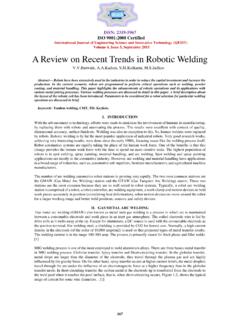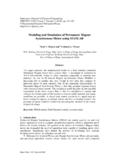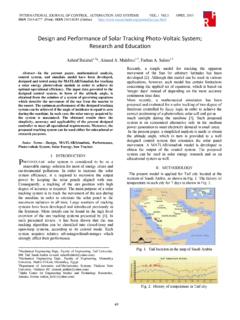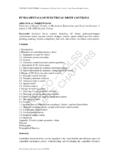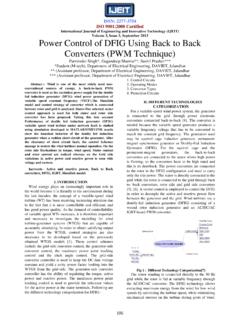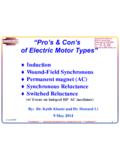Transcription of ISSN: 2319-5967 ISO 9001:2008 Certified …
1 ISSN: 2319-5967 ISO 9001:2008 Certified international journal of engineering Science and innovative technology (IJESIT) Volume 2, Issue 4, July 2013 383 Modeling Of Induction Motor and Fault Analysis , 1 Assistant Professor in EEE Department, SKCE, Arakkonam, Tamilnadu 2 Assistant Professor in EEE Department, SKCE, Arakkonam, Tamilnadu Abstract: Motor current signature analysis is the reference method for the diagnosis of induction machines faults in vector control technique, the special reference frames, electromagnetic torque of the smooth air gap machine is similar to the expression for the torque of the separately excited DC machine. Variable speed drives applications are common in the aerospace, appliance, railway, and automotive industries and also electric generators for wind turbines. In this paper, a simple and effective technique is presented that allows the diagnosis of machines faults for induction machines drives in vector control technique.
2 In case of induction machines the control is usually preformed in the reference frame (d-q) attached to the rotor flux space vector. Simulation and experimental results are shown to validate the scheme. Keywords: Induction motor, vector control, Simulink, Matlab, fault analysis, parameter. I. INTRODUCTION Introduction motors are widely used in industrial applications for their intrinsic ruggedness and reduced cost. Recently, the use of adjustable speed drives has spread in many applications. Most of the industrials motors are used today are in fact induction motors. Induction motors have been used in the past mainly in applications requiring a constant speed because conventional methods of their speed control have either been expensive or highly inefficient. This type of control scheme uses more mathematical calculations and algorithms, which involves heavy computing and needed efficient and costly controllers.
3 Here we introduce a novel theory to improve the performance of the motor running it at optimum voltage and frequency for optimum motor efficiency at different is an offline method and not for online and real time control. In some applications, where continuous operation is a key item, such as railway applications. And a wind generator, The need for a preventive fault diagnosis is an extremely important point. In this paper, fault detection and the prognosis of rotor faults are critical for industrial applications, although rotor Faults share only about20% of the overall induction machine faults [1]. In fact, the breakage of a bar leads to high current in adjacent bars, thus leading to potential further breakage and stator faults as well. II. PERFORMANCE OF INDUCTION MOTOR Energy supplied to the induction motor is distributed in the two parts, the first is in the form of mechanical output and second one is in the form of losses.
4 For the high performance of the motor the motor losses should be small, so the output of motor goes high. An efficient motor not only saves the energy, hence money, but will also generate Less internal heat, and run cooler and more quietly [2]. It is also likely to last longer and more reliable than a less efficient motor. The better performance of the motor is related to the maximum efficiency of the motor. There are different methods to improve the performance of the induction motor. Variable speed drive (VSD) is most applicable technology for the improvement of motor performance. VSD is used to regulate the speed of a motor to suit with the load demand. A VSD offers the reduce power, wider speed, torque and power ranges, and shorter response time. Induction motor efficiency is dependent on many motor parameters; however it is a function of the operating speed and applied voltage, frequency.
5 III. CONTROL OF INDUCTION MACHINEDRIVES Nowadays, common solutions for high-power applications are based on drives that include a voltage source inverter (VSI) feeding an induction motor or a permanent magnet synchronous motor. However, old-fashioned solutions based on a current source inverter or on thyristors are still employed, whereas old schemes based on dc series motors or direct dc motors are no longer used. Different control schemes are adopted and tailored to the specific application. Typically, variable structure controls are used for high-performance traction drive systems that change according to the operating conditions, particularly according to the speed and flux levels. The basic structure is a direct rotor flux field-oriented vector control, whose scheme is shown in Fig. 1. The vector control algorithm consists of two current loops for flux ISSN: 2319-5967 ISO 9001:2008 Certified international journal of engineering Science and innovative technology (IJESIT) Volume 2, Issue 4, July 2013 384 and torque regulation.
6 Moreover, an external rotor flux loop is used to set the flux level by means Of the direct stator reference current. A similar control structure is used in high-power applications, where transient operations often occur. Direct and inverse Clark transformations are represented by blocks Dand, respectively. Standard PI regulators with anti windup systems are used for the control loops in a (d-q) reference frame that is synchronous with the rotor flux. The rotor flux is estimated through a stator-model-based observer obtained by integrating the stator voltage equation and taking into account the leakage flux [3] as (1) Where is the magnetizing inductance, is the rotor inductance and is the stator are the space vectors of the stator voltage and current, respectively; this corresponds to the voltage current observer block in Fig. the actual implementation of (1), a low-pass filter is used instead of a pure integrator.
7 This choice reduces drifts due to errors and offsets in the acquired signals. However, the uses of low-pass filter results in a wrong computation of the rotor flux space vector in terms of magnitude and angle. An estimate of the stator pulsation is used to compensate for these errors, , (2) Whereis the measured mechanical speed, p is the pole pairs number, is the reference value for the torque current, is the reference value for the rotor flux, and is the rotor resistance. Relationship (2) is represented in Fig. 1 by the stator frequency estimation block and is used for three main purposes. It is used as the feed-forward compensation in the phase-locked loop (PLL) block used for the tracking of the flux angle. As stated previously, it is used to compensate for errors in the magnitude and the angle of the rotor flux caused by the low pass filter used for the integration. Eventually, it is used in the decoupling terms that are blocked together with the magnitude of the rotor flux estimated by (1) and the measured currents in the synchronous reference frame to compute the dynamic back electromotive- force compensation terms (4) The magnitude of the estimated flux is eventually used as a feedback signal for the outer loop.
8 The output of the PLL block, which is the tracked and Corrected rotor flux angle, is used for the reference frame matrix transformations () and (). The value of the reference quadrature stator current is obtained from the reference torque and the reference flux signal through the following equation: (5) Where = (2 /3p). On the other hand, the reference flux is obtained by relying on the nominal values for the torque and the rotor flux, , (6) This choice keeps the slip frequency quite constant, providing better robustness of the control system against speed errors and reducing the losses at low torque. This is suited to traction applications, where high-torque dynamics are not requested, and it does not prevent reaching the maximum torque at low speed when needed. In this paper, reference is made to an induction motor drive fed by a pulse width modulation (PWM) VSI insulated-gate bipolar transistor inverter.
9 Typically, in traction drive systems, the switching frequency is very low, making the detection of the faults through the signal injection strategy impossible. Moreover, industries are particularly interested in diagnostic techniques that do not require additional sensors. This paper proposes a simple processing technique that exploits already available control signals for the rotor fault diagnosis. ISSN: 2319-5967 ISO 9001:2008 Certified international journal of engineering Science and innovative technology (IJESIT) Volume 2, Issue 4, July 2013 385 IV. VECTOR CONTROL Vector control is the most popular control technique of AC induction motors. In special reference frames, the expression for the electromagnetic torque of the smooth-air-gap machine is similar to the expression for the torque of the separately excited DC machine. In the case of induction machines, the control is usually performed in the reference frame (d-q) attached to the rotor flux space vector.
10 That s why the implementation of vector control requires information on the modulus and the space angle (position) of the rotor flux space vector. The stator Currents of the induction machine are separated into flux- and torque-producing components by utilizing transformation to the d-q coordinate system, whose direct axis (d) is aligned with the rotor flux space vector. That means that the q-axis component of the rotor flux space vector is always zero. Fig. 1 2500 kW, 3 kV, 24,000 rpm induction motor Complete block diagram of vector control method To perform vector control, follow these steps: Measure the motor quantities (phase voltages and Currents) Transform them to the 2-phase system ( , ) Using a Clarke transformation Calculate the rotor flux space vector magnitude And position angle Transform stator currents to the d-q coordinate System using a Park transformation ISSN: 2319-5967 ISO 9001:2008 Certified international journal of engineering Science and innovative technology (IJESIT) Volume 2, Issue 4, July 2013 386 The stator current torque- () and flux- () Producing components are separately controlled The output stator voltage space vector is calculated using the decoupling block An inverse Park transformation transforms the Stator voltage space vector back from the d-q Coordinate System to the 2-phase system fixed with the stator Using the space vector modulation, the output 3-Phase voltage is generated The components and, calculated with a Clarke transformation, are attached to the stator reference frame , in vector control; all quantities must be expressed in the same reference frame.






